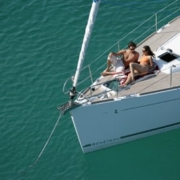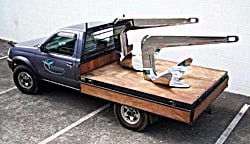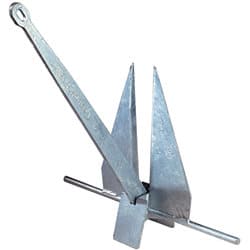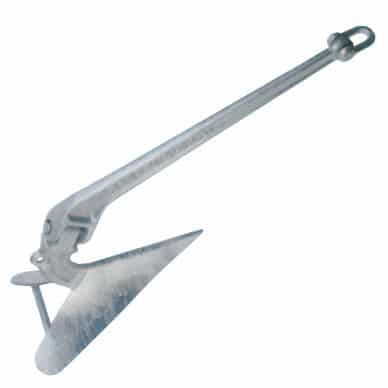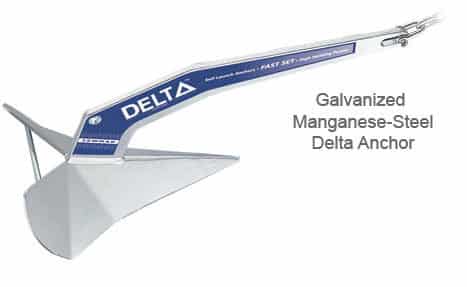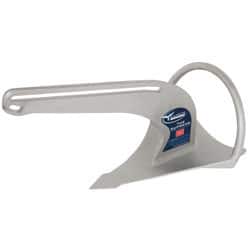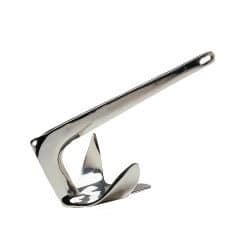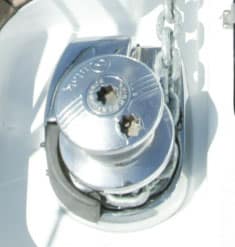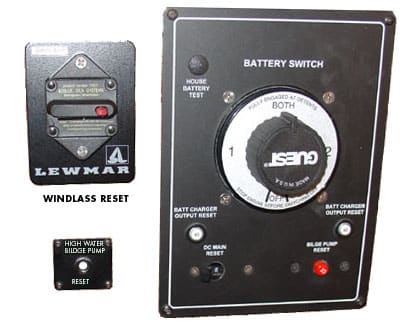Anchoring Basics
OK, so since much of the time on a charter trip is spent anchored in a really awesome location sipping on a gin or your favorite drink, and/or taking a run on the beach away from the boat, and/or dining in a beachside restaurant with a great evening sea breeze, and/or touring the island and sleeping most nights on the boat anchored – then anchoring becomes a fairly important topic, right?
So even though we said that we’d not cover sailing basics in this Bareboat Charter Clinic, forgive us if we go back to the complete basics of anchoring just to make sure you’ve got it all. Hope that’s ok and we don’t bore some of the more advanced people. But you never know some old sailing dogs do learn new tricks.
This discussion takes place on the next 4 pages
Below here we’ll discuss:
- Why it’s important to have anchoring skills,
- Selecting the type of anchor for the seabed,
- Rode
- The electric windlass.

Photo Courtesy of Beneteau
Why Anchor
Why anchor when you have a wonderful slip to come home to? Today many sailors keep their vessels in well-maintained marinas that offer a variety of amenities, including pools, restaurants, cable, bathing, and clothes washing facilities. These are convenient and safe.
Marinas offer protection from inclement weather and provide a modicum of security for vessels and occupants. So why do you need to learn about anchoring and picking up a mooring as you begin to learn to sail? Can’t that skill come later?
There are many good reasons why knowing how to anchor is important, including:
- Emergency Anchoring. You are in a spot where wind and current are pushing you dangerously towards objects you do not want to hit and your engine will not start. In this case, anchoring becomes critical.
- Wishing to take a break, sit quietly in your vessel, take a swim, fish, and/or enjoy the ambiance of the location and your crewmate’s antics, all the while knowing you are securely anchored.
- Find a location where you wish to spend considerable time, and there are no slips or moorings. Shangri-la.
- Experiencing Mother Nature’s capriciousness as the wind abates and you decide to wait for it to return.
- For some unknown reason, your engine is failing to start just as you decide to motor. No emergency, but you wish to hold still while fixing the problem or nuisance.
- Minor medical problem needing your attention, which is best done standing still.
- Legally you must have an anchor and the necessary line (rode) needed for anchoring in case of an emergency. A wise sailor will carry at least two sets of anchors.
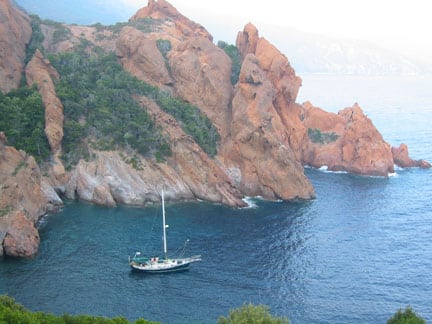
Anchored up in Corsica. A truly lovely place.
Anchoring is not simply throwing a “hook” and letting out a line. Although by watching some sailors this seems to be their theory. The best way to approach anchoring is to dissect it into a series of individual steps.
Selecting the spot – Consider the bottom – Deploying – Setting – Watching – Retrieving.
Anchoring is not always easy even when you understand these “baby steps”. There are many factors to consider: depth under keel and surrounding area depth, tidal currents, low tide depth, tidal rise, other boats in proximity, wind speed and direction changes, type of bottom, and length of stay. All factors play into your anchoring decisions.
Size of Anchor:
Anchors are selected based on vessel size and bottom conditions. The larger the vessel, the larger and heavier should be the anchor. The following table will give you the typical boat size vs. anchor weight:
|
Vessel Length |
Approx Anchor Weight depends on design |
|
20 ft (6m) |
14lb (6 kg) |
|
30 ft (9m) |
22lb (10 kg) |
|
40 ft (12m) |
35lb (17 kg) |
|
50 ft (15m) |
44 lb (20 kg) |
A little more than 44lbs here
Anchor Type:
Anchor types are selected based on the bottom conditions. These are rock, mud, clay, sand, grass, coral and shoal.
Charts will usually tell you what the bottom conditions are, as will local sailors from whom you should never be afraid to ask.
The following table shows the type of anchor and the associated bottom that the anchor is best suited for.
|
Anchor Type |
Best For |
OK for |
|
Danforth |
Sand, Mud |
|
|
Hinged Plough: CQR |
Sand, Rock, Mud, |
Clay, Grass |
|
Non-Hinged Plough: Delta |
Sand, Rock, Clay, Mud |
Grass |
|
Non Hinged Plough: Roll Bar |
Sand, Rock, Mud, Clay, Grass |
|
|
Bruce |
Sand, Rock, Mud |
Clay, Grass |
Danforth Anchor
Hinged Plough CQR Anchor
Non-Hinged Plough Delta Anchor
Non-Hinged Plough Roll Bar Anchor
The Roll Bar Plough type anchor is a new type of anchor and therefore is not that common yet. However, tests show that it is certainly one of the winners when it comes to selecting an anchor.
Bruce Anchor
Rode:
Rode is the stuff that attaches the anchor to the boat. Rode can be all chain, all rope, or more commonly a combination of rope and chain. Anchors work best when they are being pulled horizontally across the bottom. This is achieved by making the rode from the anchor to the boat as long as possible and by making the rode as heavy as possible.
All chain then is best for holding power because of its weight, but chain is expensive and almost certainly will require an electric windlass to retrieve. All rope provides poor holding power because it pulls the anchor up at an angle. For these reasons, you’ll usually encounter a combination of chain and rope. Usually, about 20-30 ft (6-9m) of chain attached to the anchor is common. The chain is heavy enough to hold the shank of the anchor down against the bottom, vastly increasing its holding power.
Chain is attached to the anchor shank by a D-Ring. It is extremely important to use stainless steel wire to tie the pin on the D-Ring closed and locked. If the D-Ring comes undone (which it will) you will lose the anchor – probably at the worst time.
An effective solution to making a rope rode lay closer to the bottom is to deploy a weight down the anchor rode. This makes the direction of the pull on the anchor closer to horizontal.
Electric Windlass:
Many modern vessels are now equipped with an electric windlass. This powerful electric winch greatly facilitates the lowering and raising of an anchor. Since they are powerful, they use a substantial amount of DC power that can rapidly drain your battery.
The size and strength of electric windlass depend upon factors of vessel length, displacement, and type of rode. Most windlasses will accommodate both chain and line.
Usually, there is an electric breaker/reset switch for the windlass. The breaker prevents too much current from overheating the wires to the windlass. If this “pops” you had either too much tension on the rode or you held the button on too long. You’ll need to hit the reset switch, which is not usually in a very convenient location. On some boats, it’s next to the battery switch.
The electric windlass is not designed to pull the boat towards the anchor. The way to pull in the anchor using a windlass is to use what is called the catenary effect. This is the weight of the chain rising in a curve off the bottom. When the chain is pulled in a little, the new curve formed by the chain weight pulls the boat forward. In this manner then, when pulling in the anchor, you should first hold the windlass “up” button down for only 5 seconds or so. Then let off and watch the boat move forward. Then use another 5-second burst and repeat. If you don’t do this you could overload your windlass and certainly reduce its working life.
Watch out also for the chain stacking on top of itself in the anchor locker. It can quickly back itself up into the windlass and cause a nasty jam that is difficult, at best, to get clear. Train your crew on this when asking them to pull in the anchor.
When letting out, most windlasses allow you to loosen the winch spindle a little so that the rode can free wheel out. On some, you simply place the winch handle into the top of the center of the winch and turn it counterclockwise to loosen.
The electric windlass always has an electric breaker reset switch. If you over-tension the rode, chances are that the breaker will trip preventing the windlass from working. You can easily reset the breaker but you have to know where on the boat the switch is and it won’t be next to the windlass. More than likely it will be below decks next to the battery selector switch, but always ask before you depart on an unfamiliar boat.
There are hand-powered devices to raise anchors. Indeed some of the electric windlasses have this added feature to help save DC power or in the event, power has been lost. Here power is from a human being pulling on a lever attached to the windlass.
Carefully check electric windlasses, including practicing the operation of these devices – before you intend to use them in a real anchoring situation. These are not toys and if the anchor line and chain get jammed on the winch, it can be a problem.
On the next page, we’ll discuss selecting an anchoring spot, considering the bottom, and deploying the anchor.

